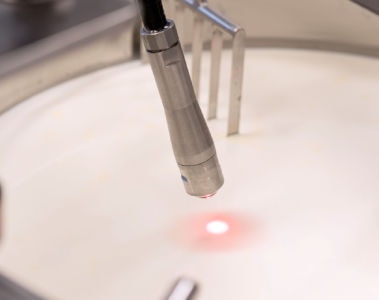
News
julio 1, 2022
Hacer la leche más sostenible: del concepto al consumo
When it comes to delicious, nutritious - and natural - foods, nothing comes to mind like milk. Full of nutrients like calcium, magnesium, and protein, it’s both a food and a beverage. And of course, for humans (indeed all mammals) it’s the first sustenance to pass our lips after being born.
Milk is good for us. But it also has the potential to be even better for us with the right science-based solutions and expertise. Furthermore, milk needs to be good for both the planet and the farmers and dairies that produce it. In fact, milk is an essential component of our global food system – which of course is under greater strain than ever with the world’s population set to hit 10 billion by 2050, including many millions of new mouths hungry for protein.
To put that into perspective, every single dairy cow generates three tons of Co2 equivalent each per year; while the methane naturally produced by cows is the major source of GHG emissions in agriculture. The question is, what can we do as industry to balance and tackle all these interconnected challenges? Here at dsm-firmenich our purpose is to create brighter lives for all – and when it comes to food and beverages, we want all the players in the dairy food system to enjoy it all: from concept to consumption.
When it comes to delicious, nutritious - and natural - foods, nothing comes to mind like milk. Full of nutrients like calcium, magnesium, and protein, it’s both a food and a beverage. And of course, for humans (indeed all mammals) it’s the first sustenance to pass our lips after being born.
Milk is good for us. But it also has the potential to be even better for us with the right science-based solutions and expertise. Furthermore, milk needs to be good for both the planet and the farmers and dairies that produce it. In fact, milk is an essential component of our global food system – which of course is under greater strain than ever with the world’s population set to hit 10 billion by 2050, including many millions of new mouths hungry for protein.
To put that into perspective, every single dairy cow generates three tons of Co2 equivalent each per year; while the methane naturally produced by cows is the major source of GHG emissions in agriculture. The question is, what can we do as industry to balance and tackle all these interconnected challenges? Here at dsm-firmenich our purpose is to create brighter lives for all – and when it comes to food and beverages, we want all the players in the dairy food system to enjoy it all: from concept to consumption.
Sustainability starts at the source
Sustainability starts at the source
There are various ways to help create a truly sustainable food system, but we believe that one of the most effective is to start at the source. In the case of milk production, that means the cow – and more specifically reducing the GHG emissions they produce that contribute to global warming and climate change.
To help tackle this challenge, the bright minds at dsm-firmenich have developed an enzyme-based feed additive called Bovaer® that consistently reduces enteric methane emissions from dairy cows by 30%. This breakthrough innovation works by suppressing the enzyme that triggers methane production in a cow’s rumen. It’s good for the planet but also for dairy farmers; enabling them to reduce their environmental footprint and meet sustainability targets.
Healthier planet, healthier people
Healthier planet, healthier people
At dsm-firmenich we have made firm food system commitments to enable double-digit livestock emission reductions by 2030. However, improving the dairy food system is not just about sustaining livelihoods and planet – it’s also about sustaining and nurturing the health of people through the milk they drink.
Around 61% of consumers globally[1] are more conscious of leading healthier lifestyles, post pandemic and many want to know more about the influence of food on their health and are now seeking solutions enriched with additional vitamins and minerals. For example, 46% of worldwide consumers[1] have turned to food to boost their immune health.
That’s why at dsm-firmenich, our specialists work with dairy manufacturers every day to make their products even more nutritious by fortifying them with a broad portfolio of vitamins, minerals and probiotics – for example, vitamins A, D and E which support immunity and wellbeing.
Taste and texture: still king
Taste and texture: still king
And of course, we should never forget that while most of us begin our lives consuming milk primarily for nutrition purposes, many millions of people continue to enjoy milk well into adulthood because they love the flavor and sensory experience.
This is another area of expertise that we provide to the dairy industry: for example, with our Maxilact® lactase enzyme which provides a natural sweet taste and smooth mouthfeel while reducing sugar content by up to 20% in milk. Or we can even modulate natural taste in applications like sports protein drinks and meal replacement shakes with our ModuMax® solution - which helps create preferred taste profiles in dairy products with high-intensity sweetener or lower fat, while improving mouthfeel. Nor forgetting, our MaxiPro® - enzymes which enable increased protein functionality, balancing taste and texture.
In fact, our texture improvement solutions are also complemented by a unique and extensive portfolio of cultures and hydrocolloids (like pectin and biogums) that support our customers in improving and creating variation in mouthfeel and texture of dairy products like yogurts – not just locally but globally.
At dsm-firmenich we have global reach and understanding of market trends, dairy technology and regulations across the world, which enables us to help our customers expand – by keeping on top of rapidly evolving trends, creating new ideas and products
Granted, balancing the needs for taste, texture and health of consumers, planet and livelihoods isn’t an easy job. But from concept to consumption, we’re striving harder than ever to ensure that everyone in the dairy food system can enjoy it all.
Cuando se trata de alimentos deliciosos, nutritivos y naturales, nada nos viene a la mente como la leche. Lleno de nutrientes como calcio, magnesio y proteínas, es a la vez un alimento y una bebida. Y, por supuesto, para los humanos (de hecho, para todos los mamíferos) es el primer sustento que pasa por nuestros labios después de nacer.
La leche es buena para nosotros. Pero también tiene el potencial de ser aún mejor para nosotros con las soluciones y los conocimientos científicos adecuados. Además, la leche tiene que ser buena tanto para el planeta como para los ganaderos y las centrales lecheras que la producen. De hecho, la leche es un componente esencial de nuestro sistema alimentario mundial, que por supuesto está sometido a más presión que nunca, ya que la población mundial alcanzará los 10.000 millones en 2050, lo que incluye muchos millones de nuevas bocas hambrientas de proteínas.
Para ponerlo en perspectiva, cada vaca lechera genera tres toneladas de Co2 equivalente cada una al año; mientras que el metano producido naturalmente por las vacas es la principal fuente de emisiones de GEI en la agricultura. La pregunta es: ¿qué podemos hacer como industria para equilibrar y afrontar todos estos retos interconectados? En DSM nuestro propósito es crear vidas más brillantes para todos - y cuando se trata de alimentos y bebidas, queremos que todos los actores del sistema alimentario lácteo disfruten de todo: desde el concepto hasta el consumo.
La sostenibilidad empieza en la fuente
Hay varias formas de ayudar a crear un sistema alimentario verdaderamente sostenible, pero creemos que una de las más eficaces es empezar por la fuente. En el caso de la producción de leche, se trata de la vaca y, más concretamente, de reducir las emisiones de GEI que produce y que contribuyen al calentamiento global y al cambio climático.
Para ayudar a afrontar este reto, las mentes brillantes de DSM han desarrollado un aditivo enzimático para piensos llamado Bovaer® que reduce sistemáticamente las emisiones entéricas de metano de las vacas lecheras en un 30%. Esta revolucionaria innovación actúa suprimiendo la enzima que desencadena la producción de metano en el rumen de las vacas. Es bueno para el planeta, pero también para los productores lácteos, ya que les permite reducir su huella ambiental y cumplir sus objetivos de sostenibilidad.
Planeta más sano, personas más sanas
En DSM hemos asumido compromisos firmes con el sistema alimentario para permitir reducciones de dos dígitos en las emisiones del ganado para 2030. Sin embargo, la mejora del sistema alimentario lácteo no consiste sólo en preservar los medios de subsistencia y el planeta, sino también la salud de las personas a través de la leche que beben.
Alrededor del 61% de los consumidores de todo el mundo[1] están más concienciados de llevar estilos de vida más saludables, tras la pandemia, y muchos quieren saber más sobre la influencia de los alimentos en su salud y buscan ahora soluciones enriquecidas con vitaminas y minerales adicionales. Por ejemplo, el 46% de los consumidores de todo el mundo[1] han recurrido a la alimentación para reforzar su salud inmunitaria.
Por eso, en DSM Food & Beverage, nuestros especialistas trabajan cada día con los fabricantes de productos lácteos para hacer que sus productos sean aún más nutritivos enriqueciéndolos con una amplia cartera de vitaminas, minerales y probióticos, por ejemplo, vitaminas A, D y E que favorecen la inmunidad y el bienestar.
Sabor y textura: siguen siendo los reyes
Y, por supuesto, nunca debemos olvidar que, aunque la mayoría de nosotros empezamos nuestra vida consumiendo leche principalmente con fines nutritivos, muchos millones de personas siguen disfrutando de la leche hasta bien entrada la edad adulta porque les encanta su sabor y su experiencia sensorial.
Esta es otra de las áreas de especialización que aportamos a la industria láctea: por ejemplo, con nuestra enzima lactasa Maxilact® , que proporciona un sabor dulce natural y una sensación suave en boca, al tiempo que reduce el contenido de azúcar hasta en un 20% en la leche. O incluso podemos modular el sabor natural en aplicaciones como bebidas proteicas para deportistas y batidos sustitutivos de comidas con nuestra solución ModuMax®, que ayuda a crear perfiles de sabor preferidos en productos lácteos con edulcorantes de alta intensidad o menos grasa, al tiempo que mejora la sensación en boca. Sin olvidar nuestras enzimas MaxiPro®, que permiten aumentar la funcionalidad de las proteínas, equilibrando el sabor y la textura.
De hecho, nuestras soluciones de mejora de la textura también se complementan con una amplia y exclusiva cartera de cultivos e hidrocoloides (como pectina y biogumas) que ayudan a nuestros clientes a mejorar y crear variaciones en la sensación en boca y la textura de productos lácteos como los yogures, no sólo a nivel local, sino también mundial.
En DSM tenemos un alcance global y comprendemos las tendencias del mercado, la tecnología láctea y las normativas de todo el mundo, lo que nos permite ayudar a nuestros clientes a expandirse, manteniéndonos a la vanguardia de las tendencias en rápida evolución, creando nuevas ideas y productos.
Es cierto que equilibrar las necesidades de sabor, textura y salud de los consumidores, el planeta y los medios de subsistencia no es tarea fácil. Pero desde el concepto hasta el consumo, nos esforzamos más que nunca por garantizar que todos los integrantes del sistema alimentario lácteo puedan disfrutar de todo ello.
Referencias
- FMCG-Gurus-Identifying-Key-Trends-in-the-USA/Europe-Plant-Based-Dairy-Market-2021

